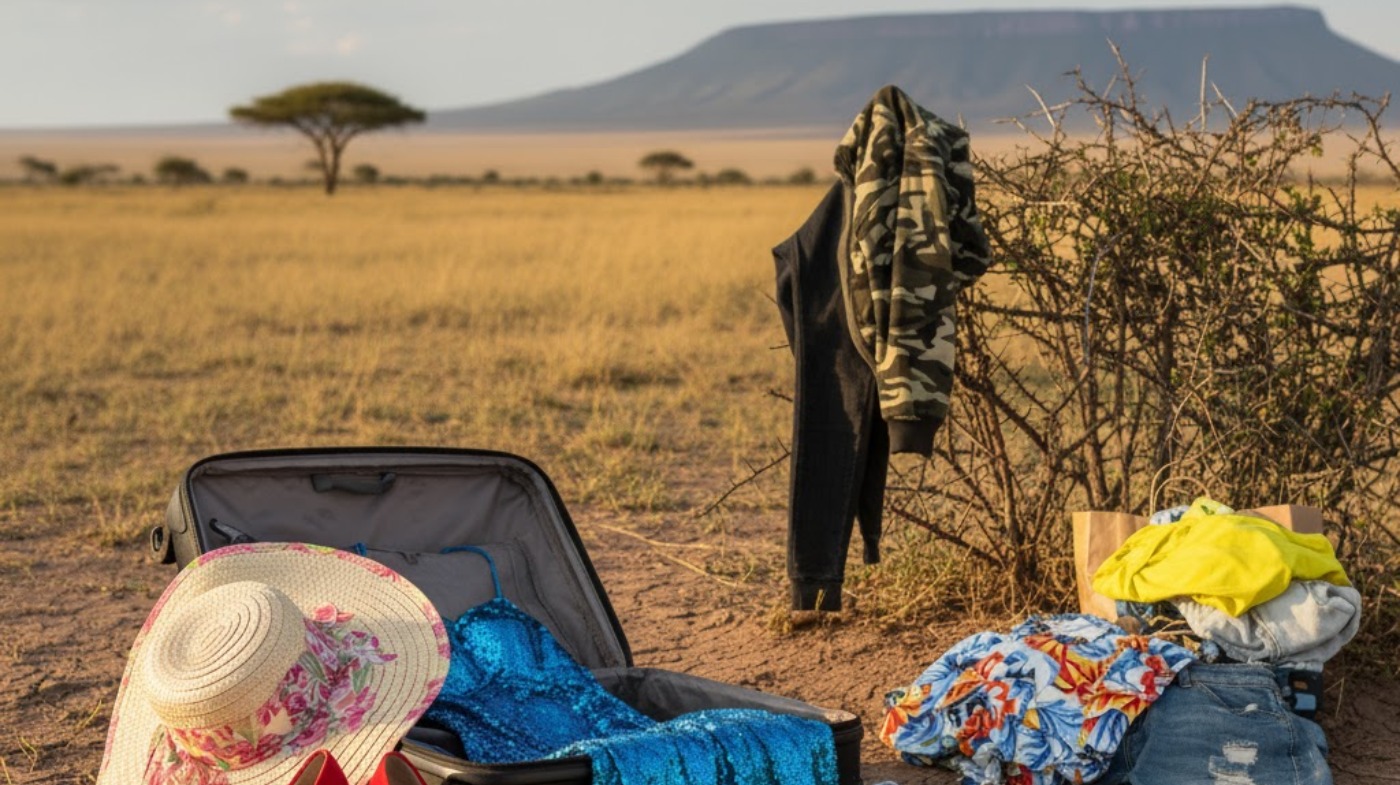10 Clothing Mistakes Tourists Make on Safari in Tanzania
Planning an African safari in Tanzania is thrilling, but many tourists unknowingly sabotage their experience with poor clothing choices. From attracting dangerous insects to offending local customs, wardrobe mistakes can transform your dream adventure into an uncomfortable ordeal.
Understanding what to wear and what to avoid ensures you stay safe, comfortable, and respectful throughout your journey.
This comprehensive guide reveals the ten most common clothing errors tourists make and provides practical solutions to help you pack smartly for your Tanzanian safari adventure.
10 Common Tanzania Safari Clothing Mistakes and Solutions
The foundation of a successful safari experience begins with your wardrobe. Many first-time visitors make critical errors that compromise their comfort and safety.
Wearing Bright Colors and White Clothing
Neon pinks, electric blues, and stark whites might look stunning in photos, but they create serious problems on safari. Bright colors startle wildlife and make it nearly impossible for guides to position vehicles for optimal viewing opportunities.
White fabric becomes a dust magnet within hours, looking grimy before your first game drive ends. These vibrant shades also disrupt the natural environment and can agitate animals during crucial wildlife encounters.
Stick to earthy tones like khaki, olive, beige, and brown that blend seamlessly with the savannah landscape. These neutral colors keep you comfortable while maximizing wildlife sightings throughout your safari. Even on a cheap Tanzania safari, affordable neutral-colored clothing from regular retailers works perfectly without requiring expensive safari-specific gear.
Choosing Black and Dark Blue Fabrics
Dark clothing seems practical until you discover it attracts tsetse flies; aggressive biters drawn specifically to black and navy blue colors. These insects deliver painful bites that can ruin entire days of your safari experience.
The intense Tanzanian sun also makes dark fabrics unbearably hot during midday game drives. Heat absorption in black clothing creates unnecessary discomfort when temperatures soar across the plains.
Select lighter earth tones and tan shades that reflect sunlight and keep tsetse flies at bay. This simple switch dramatically improves your comfort level throughout multiple game drives.
Packing Camouflage Print Clothing
Many tourists assume camouflage patterns are perfect for safari environments. However, camouflage clothing is strictly prohibited in Kenya and Tanzania African countries, where it’s reserved exclusively for military personnel.
Wearing camo prints can result in serious legal complications with local authorities. Security personnel may detain visitors sporting military-style patterns, creating unnecessary stress during your vacation.
Choose solid neutral colors or subtle patterns instead of camouflage designs. Non-military-inspired clothing keeps you compliant with local regulations while maintaining appropriate safari attire.
Exposing Too Much Skin
Skimpy outfits might seem ideal for beating African heat, but they leave you vulnerable to sunburn, mosquito bites, and scratches from thorny vegetation. The relentless equatorial sun causes severe burns on exposed skin within minutes.
Revealing clothing also disrespects local cultural norms, particularly when visiting villages or towns where Tanzanian communities value modest dress. Cultural sensitivity enhances your safari experience and demonstrates respect for local traditions.
Opt for loose, long-sleeved shirts and lightweight pants made from breathable fabrics. These garments protect your skin while keeping you cool and culturally appropriate throughout your journey.
Wearing Tight or Restrictive Clothing
Safari days involve long, bumpy drives, crouching for photos, and scrambling into vehicles multiple times daily. Restrictive clothing makes these activities miserable and limits your mobility during crucial wildlife moments.
Tight fabrics also prevent proper air circulation in hot conditions, leading to discomfort and chafing during extended game drives. Flexibility and comfort are essential for enjoying full-day safari adventures.
Select loose-fitting, stretchy garments that allow unrestricted movement. Comfortable clothing ensures you can fully participate in all safari activities without physical limitations.
Bringing Heavy Fabrics Like Jeans
Denim jeans are impractical for safari conditions—they’re too hot during the day, take forever to dry, and become uncomfortable during long vehicle rides. Heavy fabrics trap heat and moisture against your skin in tropical climates.
Jeans also occupy valuable luggage space without providing the versatility needed for changing safari conditions. When considering what to pack for safari in Tanzania, lightweight alternatives offer superior performance.
Pack lightweight, quick-drying convertible pants that transform into shorts when temperatures rise. These versatile garments adapt to fluctuating conditions while conserving precious luggage space.
Forgetting Layering Essentials
Many tourists underestimate how cold early morning game drives become, especially in areas like the Serengeti or Ngorongoro Crater. Temperatures drop significantly before dawn, making single-layer outfits inadequate for comfort.
The best time to visit Tanzania’s Serengeti coincides with cooler dry season mornings when fleece jackets become essential. Evening temperatures also plummet after sunset, requiring warm layers for outdoor dining.
Overlooking Proper Footwear
Open-toed sandals and flimsy flip-flops provide insufficient protection for bush walks and uneven terrain around safari camps. Exposed toes are vulnerable to insect bites, thorns, and potential injuries during outdoor activities.
Inappropriate footwear also limits participation in optional walking safaris and bush adventures that require sturdy shoes. When exploring what shoes to wear on safari in Tanzania, proper footwear expands your adventure opportunities.
Choose comfortable closed-toe walking shoes or lightweight hiking boots for daytime activities. Reserve sandals exclusively for relaxing around lodges after game drives conclude.
Adding Noisy Accessories and Strong Scents
Chunky jewelry, dangling bracelets, and clinking accessories create noise that spooks sensitive wildlife. These sounds alert animals to human presence, reducing your chances of close encounters during game drives.
Heavy perfumes and colognes attract insects while potentially irritating animals with sensitive olfactory systems. Strong artificial scents disrupt the natural environment and compromise wildlife viewing opportunities.
Overpacking Unnecessary Items
First-time safari visitors often bring excessive luggage despite strict weight limits on bush flights, which typically allow only 15 kilograms in soft-sided bags. Overpacking creates logistical problems and unnecessary stress during travel transitions.
Many tourists pack formal wear and unnecessary clothing items that remain unused throughout their safari. Most Tanzania luxury safari lodges offer laundry services, eliminating the need for excessive outfit changes.
Pack strategically with versatile pieces that mix and match easily. Focus on quality over quantity, bringing only essentials that serve multiple purposes throughout your safari adventure.
Essential Safari Clothing Checklist
Building the perfect safari wardrobe requires a strategic selection of versatile, functional pieces. Your clothing should protect you from the elements while maintaining comfort during extended outdoor adventures.
Pack 2-3 long-sleeved shirts in moisture-wicking fabrics that shield against the sun and insects. Include 2-3 pairs of lightweight trousers plus convertible zip-off pants for temperature flexibility.
Add a wide-brimmed hat, sunglasses with UV protection, and a lightweight rain jacket for unexpected weather. Don’t forget a warm fleece for chilly mornings and evenings during game drives.
Understanding Tanzania’s Safari Seasons
Climate significantly impacts your safari experience and clothing needs. Tanzania experiences distinct wet and dry seasons that influence wildlife viewing opportunities and packing requirements.
The dry season from June to October is widely considered the best time to visit Tanzania Serengeti for optimal wildlife viewing. During these months, animals congregate around water sources, making them easier to spot against sparse vegetation.
When is dry season in Tanzania matters when planning your wardrobe—this period features sunny days, cooler nights, and minimal rainfall. Morning temperatures can drop significantly, requiring warm layering options for early game drives.
Safari Safety and Clothing Considerations
Understanding Tanzania safari safety extends beyond wildlife precautions to include proper clothing choices. Your wardrobe directly impacts your protection from environmental hazards and health risks.
Long sleeves and pants provide essential protection against mosquitoes that carry malaria, especially during dawn and dusk when these insects are most active. Lightweight, breathable fabrics offer coverage without causing heat discomfort.
Neutral-colored clothing helps you maintain an appropriate distance from wildlife by minimizing visual disturbance. Following your guide’s instructions while wearing proper attire ensures safe, memorable wildlife encounters throughout your safari.
Choosing Between Safari Options
Budget considerations influence clothing choices when planning your African adventure. Those researching is Kenya or Tanzania is cheaper should note that Tanzania offers diverse options from budget-friendly to ultra-luxury experiences.
A cheap Tanzania safari doesn’t require expensive safari-specific clothing—affordable neutral-colored garments from regular retailers work perfectly. Focus spending on quality footwear and sun protection rather than designer safari wear.
Premium options like Tanzania luxury safari packages and luxury safari holidays in Tanzania provide laundry services and comfortable accommodations where you can refresh clothing between game drives.
Planning Your Complete Safari Experience
Beyond clothing considerations, successful safaris require comprehensive planning. Many travelers combine wildlife viewing with other adventures when booking tours and safaris in Tanzania.
Private Tanzania safari packages and private Tanzania safari tours offer personalized experiences with flexible scheduling. These options allow you to adjust activities based on comfort levels and interests throughout your journey.
Wildlife and Natural Wonders Preparation
Understanding Tanzania’s diverse ecosystems helps inform clothing choices. The country hosts incredible wildlife diversity, from Big Five animals to unique species like crocodiles in various water bodies.
When wondering if there are crocodiles in Tanzania, the answer is yes—these reptiles inhabit rivers and lakes throughout safari regions. Proper footwear prevents accidents near water sources during guided walks and camp activities.
Those seeking the best view of Kilimanjaro from Tanzania should pack layers for varying altitudes and microclimates. Mountain views often appear during morning game drives when temperatures are coolest and visibility is optimal.
Working with Professional Safari Companies
Selecting reputable operators ensures you receive accurate packing guidance and safety information. Research licensed companies certified by the Tanzania Tourist Board for reliable service and expert knowledge.
East African safari and touring company options and East Africa adventure tours and safaris providers offer valuable pre-trip consultations. These professionals provide region-specific clothing recommendations based on your specific itinerary and travel dates.
Safari Accommodation and Clothing Storage
Different Tanzania safari accommodation types influence your clothing needs and storage options. Luxury lodges provide ample space and laundry facilities, while mobile camps require more compact packing strategies.
Most accommodations include secure storage for valuables and clothing with dust protection for items not in use. Soft duffel bags fit better in tent-style accommodations compared to rigid suitcases.
Climate-controlled lodges allow you to refresh and reorganize clothing between safari segments. Take advantage of these facilities to maintain clean, appropriate attire throughout your multi-day adventure.
Tanzania Safari Experiences Worth Exploring
Planning your safari involves understanding the diverse Tanzania safari experiences available across different parks and reserves. From the vast Serengeti plains to the dramatic Ngorongoro Crater, each destination offers unique wildlife encounters.
Consider working with experienced operators who understand local conditions and can customize itineraries based on your interests. Proper clothing preparation ensures you’re ready for whatever adventures await during your East African journey.
Frequently Asked Questions
What colors should I absolutely avoid on safari?
Avoid bright colors like neon pink, electric blue, red, and white, plus black and dark blue fabrics that attract tsetse flies. Stick exclusively to neutral earth tones like khaki, olive, beige, and brown for optimal safari experiences.
Can I wear shorts on a Tanzania safari?
Yes, lightweight shorts are acceptable during hot midday periods at lodges, but long pants provide better protection during game drives. Convertible zip-off pants offer the best flexibility for changing conditions throughout the day.
Do I need hiking boots for a Tanzania safari?
Full hiking boots aren’t necessary unless you’re planning serious trekking or a Kilimanjaro climb. Comfortable closed-toe walking shoes or lightweight hiking shoes provide adequate support for most safari activities and bush walks.
Smart Wardrobe Planning Pays Off
Avoiding common clothing mistakes transforms your Tanzania safari from potentially uncomfortable to genuinely enjoyable. Proper wardrobe planning protects you from insects, sun damage, and cultural missteps while maximizing wildlife viewing opportunities.
Your clothing choices directly impact safari success—neutral colors, breathable fabrics, and appropriate coverage ensure comfort during long game drives. Remember that versatility and functionality matter more than fashion when selecting safari attire.



